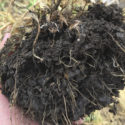Advertise Follow Us
No-Till 101
Breaking Through to the ‘Root’ Cause of Compacted Soil
Soil compaction can limit yields, cause flooding and runoff and limit nutrient uptake in plants. But breaking up compacted soils with iron is not the answer, according to soil health consultant Jim Hoorman — biology is.
Read More








